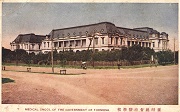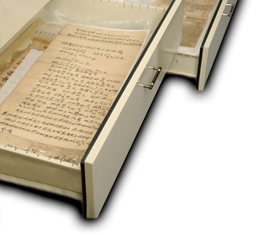
Publication date: 22 Apr 2019
Author: Jao Tsu-hsien |Staff member of the Archives of Institute of Taiwan History
On the Open House day in 2018, the Archives of the Institute of Taiwan History featured an exhibition, Travel Memories II—Taiwanese Painters’ Landscape Sketches, from digital records collected by the Archives in recent years. This exhibition selected four Taiwanese painters, Yen Shui-long, Liu Chi-hsiang, Chen Cheng-po, and Kuo Hsueh-hu, by presenting the records of their passports, certificates, photographs, correspondence, and paintings and exploring their life experiences of practicing goals, embarking on adventures abroad, and contributing to society. Let us trace the senior painters’ paths of crossing borders and pursuing dreams by appreciating these precious records and the abundant colors in their paintings!

Publication date: 09 Oct 2018
Author: Jao Tsu-hsien |Staff member of the Archives of Institute of Taiwan History
Surrounded by mountains and a river, Tamsui, which used to be called “Hobe”, has always attracted senior artists in Taiwan. Exotic and traditional buildings left by the Dutch, Qing Dynasty, and Japanese feature in its historic characteristics, attracting wandering literati. Artists are also inspired by this historic town. The paintings of Tamsui are a spectacular page of Taiwan’s art history. By following in the steps of Taiwanese artists Chen Zhi-qi, Chen Cheng-po, and Yen Shui-long, let us start a journey through Tamsui across time and space!

Publication date: 23 Jul 2018
Author: Hsieh Min-ro |Staff member of the Archives of Institute of Taiwan History
During the Qing Dynasty, before the Western medical system was established, traditional Chinese doctors were seen as the second level in the social hierarchy. After the modern systematic medical education was founded by the Japanese colonial government, doctors gained a high position in Taiwanese society. In fact, the cultivation of doctors during the colonial period reflected the transformation of the Taiwanese doctor’s social status. Using precious archives, this article introduces the establishment of Taiwan’s medical education and training system.

Publication date: 12 Mar 2018
Author: Ou Yi-han |Staff member of the Archives of Institute of Taiwan History
On Open House Day in 2017, the Institute of Taiwan History featured “Travel Memories-Journeys and Experiences in the Diaries”. The exhibition selected contents of The Diary of Ye Sheng-ji and relative photographs, postcards, itineraries, representing travel memories during the Japanese colonial period. Let us follow the travelers’ steps and enjoy impressive scenery through viewing abundant archives and experiencing a busy school excursion!



